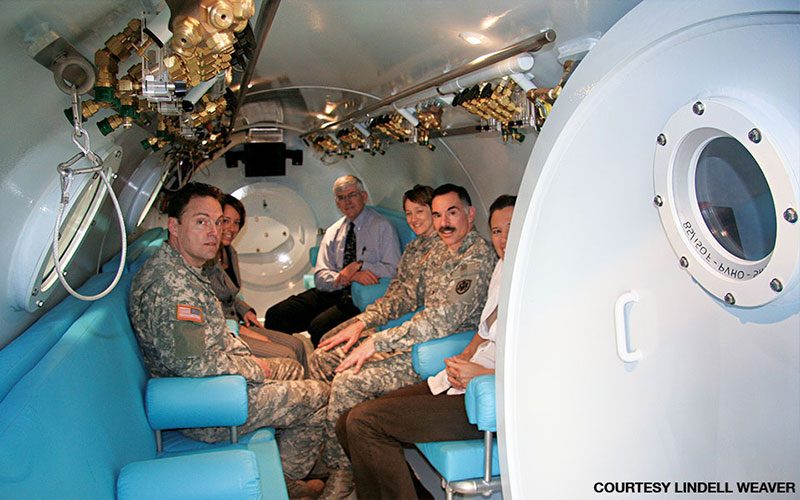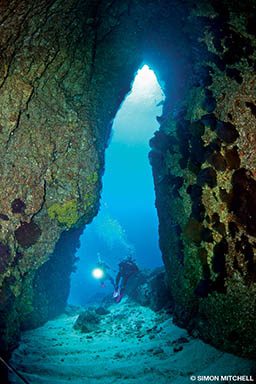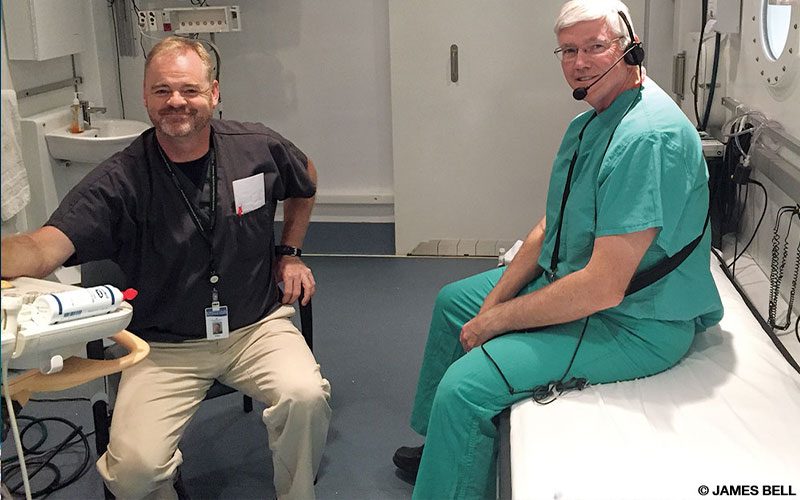With three decades of research as a testament to his dedication to hyperbaric medicine, critical-care and hyperbaric medicine physician Lindell Weaver, M.D., has spent his career treating critically ill patients and conducting research on carbon-monoxide (CO) poisoning and brain injuries. He currently serves as medical director and division chief of hyperbaric medicine at Intermountain Medical Center in Murray, Utah, and at LDS Hospital in Salt Lake City. A professor of medicine at the University of Utah School of Medicine and an adjunct professor in the Department of Anesthesiology at Duke University, he is also the principal investigator for the U.S. Department of Defense’s Brain Injury and Mechanisms of Action of Hyperbaric Oxygen for Persistent Post-Concussive Symptoms after Mild Traumatic Brain Injury randomized trial.
After completing an internship as a Navy medical officer in San Diego, Calif., Weaver became an Undersea Medical Officer and served for almost two years aboard the USS Canopus, based in South Carolina; in that role he treated divers with decompression illness (DCI). After leaving the Navy, he completed a residency in internal medicine followed by a fellowship in pulmonary and critical-care medicine in Salt Lake City.
Long interested in the effects of hyperbaric oxygen (HBO2) on the human body, Weaver has conducted research on the effects and treatment of CO poisoning and hyperbaric treatment for traumatic brain injury (TBI). His work has set standards of care in the clinical use of HBO2 and established protocols for chamber attendants working in chambers operated at increased altitude.
Weaver’s research in HBO2 for brain injuries caused by CO poisoning and trauma has broad health implications but is particularly relevant to the safety and well-being of divers. Not only does his work directly address general concerns about CO poisoning, it also illuminates the effects of CO in the diving environment. His research on the effects of CO also shows parallels between the effects of CO poisoning and decompression sickness (DCS). His work makes it possible to establish correlations between the two conditions and furthers our knowledge of hyperbaric and dive medicine.
Weaver has been an advocate for a network of 24/7 emergency hyperbaric chambers, which could dramatically improve outcomes for injured divers and clinical patients who need urgent HBO2 outside of traditional hours of operation. He has also studied the effects of vitamin D on the immune response after knee surgery and the potential mechanisms of action of HBO2 in TBI and CO poisoning, both of which are also relevant to dive safety and dive science.
The American College of Critical Care Medicine has recognized Weaver as a Fellow for his work treating people in need. We appreciate his willingness to discuss his work with us.

Do you still dive, and what first brought you to dive research?
I do still dive. As a youth one of my favorite TV shows was Sea Hunt, and I learned to dive in 1975 (with no buoyancy compensator). I have fond memories of diving in the Sea of Cortez, camping on shore and using an inflatable life raft as a dive boat. Some years later I undertook U.S. Navy training in undersea medicine and went to the Navy dive school for physicians and officers. After I left the Navy I was a dive instructor with Scuba Schools International (SSI) and the Professional Diving Instructors Corp. (PDIC). I stopped logging my dives 18 years ago when I hit 1,000. Much of my diving has been in remote spots in Baja California with only a few other divers.
You spent several years as an Undersea Medical Officer in the Navy. What effect did this have on your career path and your research?

Learning dive physiology, open-circuit scuba and surface-supplied systems (using Mark V, Mark V-Mod 1 and Mark 12 diving helmets) from very experienced military divers was incredible. As an Undersea Medical Officer on board a Navy ship, I supervised the double-lock recompression chamber. A case of gas gangrene I treated that showed rapid improvement upon reaching treatment pressure became a pivotal moment in which I decided to pursue a career in hyperbaric medicine.
What are your interests outside of your work in hyperbaric medicine?
When I first moved to Utah, deep powder skiing was my main pastime. In the past 15-20 years my primary recreational interest has become off-road adventure motorcycle riding, which is terrific in the Southwest. And of course I enjoy time with my wife and two kids — one grown, the other in high school.
You have been a proponent of 24/7 hyperbaric chambers, a position that conflicts with industry trends. What benefits might the dive community see from the widespread availability of 24/7 hyperbaric chambers?
The availability of 24/7 hyperbaric facilities is important to the health of a wide range of patients. For example, CO poisoning is the most common poisoning in the USA, with more than 50,000 people poisoned every year. HBO2 improves the outcome of CO poisoning, but only a small percentage of patients are treated in chambers. Divers in need of chamber therapy sometimes have to travel long distances, even passing over hyperbaric centers that are closed or unwilling to treat divers, which delays definitive treatment and increases cost. There are more than 1,000 hyperbaric medicine centers in the USA, most associated with wound-care centers, yet only 100 or so are open 24/7.
Much of your work pertains to the treatment of CO poisoning and reversing the effects of inflammatory responses after the initial exposure. Does this research tell us anything about the treatment of DCS?
CO poisoning is complicated because the injury causes hypoxia and inflammation. HBO2 treats the hypoxia and favorably modulates the inflammation. Very similar effects occur in DCS with hypoxia and inflammation; the parallels between these disorders with regard to HBO2 are strikingly similar in many ways.

The altitude in Salt Lake City caused some difficulties with HBO2 therapy. What can you tell us about the effects of altitude on the treatment of divers?
Our hyperbaric chamber in Salt Lake City is at 4,200 feet, so the atmospheric pressure is about 15 percent lower than the pressure at sea level. This means patients undergoing HBO2 therapy and their attendants experience greater relative pressure changes. For the patients this is not of consequence because they breathe oxygen and do not saturate with inert gas. For the attendants who breathe the chamber’s ambient compressed air, however, this represents an increased risk of DCS. We have learned that we must provide additional supplemental oxygen to chamber attendants working inside our multiplace chamber to reduce their risk of DCS.
Your facility is in a large city at high altitude with a number of attractive dive sites in the vicinity. And of course local divers also go on dive trips. Do you ever see divers with DCI in your facility?
We do have several interesting and unusual dive sites in the area. Approximately 40 miles west of Salt Lake City is a site called Bonneville Seabase. Years ago the owners excavated natural pools of mineral water and built a dive facility. The concentration of minerals is so high that the water actually supports ocean life, so you can dive there surrounded by tropical ocean fish. They also installed a surplus missile silo to allow divers to perform deeper dives.
Another unique spot is Homestead Crater in Midway, Utah. The dive site is a natural pool of very warm freshwater inside a mineral dome. The top of the dome is open, and the walls are covered in green plants. The operators bored a tunnel into the side of the dome to allow access to the pool and built a small dive shop inside. The pool is approximately 65 feet deep, and archaeologists visit to sift through the bottom, searching for artifacts. The crater is located at an elevation of about 6,000 feet, so altitude-adjusted diving is crucial.
A couple of other notable sites in Utah are Fish Lake, a fish-filled freshwater site located at about 9,000 feet, and Blue Lake, a geothermal site filled with warm water and geothermal bubbles on the border of Utah and Nevada.
We have significant experience treating divers with DCI. At last count we have evaluated 168 divers since 1985, and one of our fellows is doing research with this data now. Many were diving locally, but others were injured at sea level and got worse or developed DCS on the way home to increased altitude. Diving at some local spots may pose additional risk because of the combination of very warm water, altitude and the tendency to ascend to even higher altitudes soon after diving. There is also commercial diving in Utah in Lake Powell and Flaming Gorge, and we have treated a few commercial divers with DCI.
Is there reason to increase diver awareness of CO poisoning, and does this risk warrant the widespread use of CO monitors in diving?
CO in divers’ breathing gas is very rare, but it does occur. When I fill my own tanks I monitor the air for CO at the compressor intake. Engine exhaust is very high in CO, so caution is important to ensure CO generated by the compressor itself does not get drawn in. Whether divers should check each tank for CO, I leave to them. CO detectors are available to do this.
| © Alert Diver — Q2 2017 |